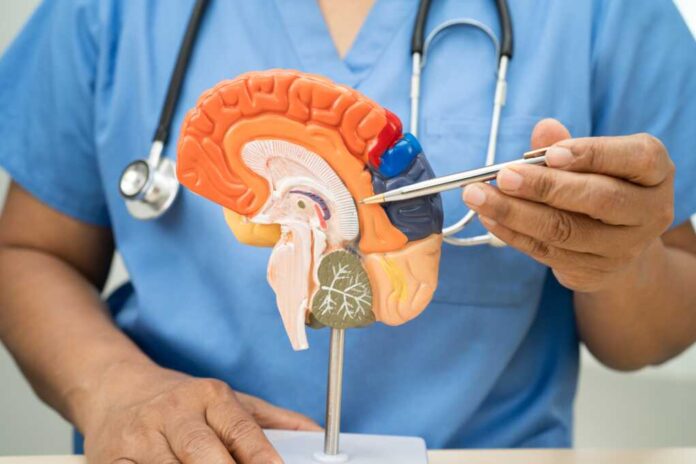
When the right frontal pole of the brain is damaged, some patients experience a surprising side effect—dramatically enhanced creative abilities that challenge our understanding of how the brain works.
At a Glance
- Scientists have identified a specific brain circuit centered in the right frontal pole that controls creativity
- Damage to this circuit can paradoxically increase creativity by removing the brain’s natural “brake” on creative thinking
- Brain injuries and certain neurodegenerative diseases can enhance creativity depending on the location of the damage
- Creative individuals process information differently, with reduced brain response to unusual stimuli
- This research offers potential new pathways for enhancing creativity through targeted brain stimulation
The Creativity Circuit: A Scientific Breakthrough
A groundbreaking study analyzing data from 857 patients across 36 fMRI studies has identified a specific brain circuit for creativity centered in the right frontal pole. This discovery challenges the traditional view that creativity is a function of specific brain regions. Instead, researchers found that creative tasks activate diverse brain regions that form part of a common circuit. The right frontal pole appears to act as a “brake” on creativity, with its deactivation potentially unleashing creative abilities that were previously constrained.
The discovery of this creativity circuit provides a framework for understanding why some individuals with brain injuries or neurodegenerative diseases suddenly display enhanced creative abilities. Rather than viewing these conditions solely as impairments, scientists now recognize that certain brain changes can actually improve functions like creativity, offering a more nuanced perspective on brain health and function.
When Brain Damage Enhances Creativity
The paradoxical relationship between brain damage and creativity has been documented in numerous case studies. Patients with specific lesions in the right frontal pole region have demonstrated remarkable increases in artistic expression, musical abilities, and innovative thinking. This phenomenon challenges conventional wisdom about the negative impacts of brain injury and suggests that what we typically consider “pathological” brain changes may actually enhance certain cognitive functions.
Researchers have also found connections between creativity and certain mental health conditions. Bipolar disorder, for instance, affects similar brain networks tied to creativity, especially those controlling attention, self-monitoring, and idea generation. This doesn’t mean all creative people have mental health conditions or that brain injury should be viewed positively, but it does highlight the complex relationship between brain function and creative expression.
Does human creativity map to a specific brain circuit? Can damage to this brain circuit increase creativity? New paper by @IsaiahNeurology @Brain_Circuits out today in @JAMANetworkOpen says answer to both is YES. Paper is open access and great thread below: https://t.co/nz6nOjrHcK
— Michael Fox (@foxmdphd) February 13, 2025
The Neuroscience of Creative Thinking
Creative individuals process information differently from others, according to recent research. They show a reduced brain response to unusual stimuli, meaning they don’t perceive unusual information as odd or surprising. This attentional difference allows them to notice unconventional details and access a broader range of information when solving problems. Scientists have identified two attentional profiles linked to creativity: “leaky” attention that allows more information in, and “watertight” attention that is more focused.
The research also revealed interesting connections between creativity and motivation. Creative people show a higher motivational drive, with a stronger desire to engage in activities (the “wanting” aspect) compared to the pleasure they derive from those activities (the “liking” aspect). This finding suggests that creativity involves not just different ways of thinking but also different patterns of motivation and reward processing.
Implications for Future Research and Treatment
This newfound understanding of the brain’s creativity circuit opens exciting possibilities for brain stimulation techniques that could enhance creativity in both healthy individuals and those with brain injuries or neurodegenerative diseases. By targeting the right frontal pole, researchers might be able to temporarily reduce its inhibitory function, potentially unlocking creative abilities. However, more research is needed to validate these findings and develop safe, effective methods for creativity enhancement.
For older adults concerned about brain health, these findings offer a new perspective. Rather than focusing solely on preventing cognitive decline, future therapies might harness the brain’s natural plasticity to enhance creative thinking and problem-solving abilities. The research also provides hope for patients with brain injuries, suggesting that rehabilitation approaches could potentially tap into these unexpected benefits of neural reorganization to improve quality of life and cognitive function.
Sources:
https://nypost.com/2025/02/13/health/scientists-link-brain-damage-to-increased-creativity/
https://jamanetwork.com/journals/jamanetworkopen/fullarticle/2830230


















